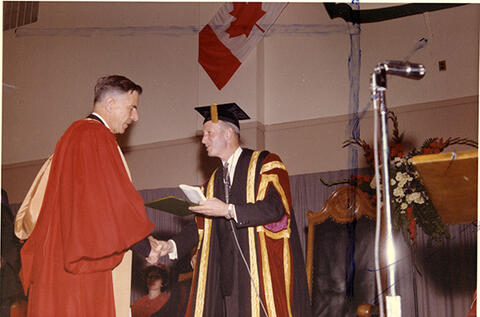
Área de título y declaración de responsabilidad
Título apropiado
Honourary Degrees - Presentation - John Kenneth Galbraith
Tipo general de material
- Graphic material
Título paralelo
Otra información de título
Título declaración de responsabilidad
Título notas
Nivel de descripción
Item
Institución archivística
Código de referencia
Área de edición
Declaración de edición
Declaración de responsabilidad de edición
Área de detalles específicos de la clase de material
Mención de la escala (cartográfica)
Mención de proyección (cartográfica)
Mención de coordenadas (cartográfica)
Mención de la escala (arquitectónica)
Jurisdicción de emisión y denominación (filatélico)
Área de fechas de creación
Fecha(s)
-
20 May 1965 (Criação)
Área de descripción física
Descripción física
1 photograph : col. ; 12.7 x 8.9 cm
1 negative
Área de series editoriales
Título apropiado de las series del editor
Títulos paralelos de serie editorial
Otra información de título de las series editoriales
Declaración de responsabilidad relativa a las series editoriales
Numeración dentro de la serie editorial
Nota en las series editoriales
Área de descripción del archivo
Nombre del productor
Historial de custodia
Alcance y contenido
E.M. (Ted) Culliton, University Chancellor, making presentation of an honourary Doctor of Laws degree to John Kenneth Galbraith at Convocation held in Physical Education gymnasium.
Bio/Historical Note: John Kenneth Galbraith, known as Ken Galbraith, was born in 1908 at Iona Station, Ontario. After study at the University of Toronto’s Ontario Agricultural College (now part of the University of Guelph; BS 1931) and the University of California, Berkeley (PhD 1934), Galbraith, who became a U.S. citizen in 1937, taught successively at Harvard and Princeton universities until 1942. During World War II and the postwar period, he held a variety of government posts and served as editor of Fortune magazine (1943-1948) before resuming his academic career at Harvard in 1948. He established himself as a politically active liberal academician with a talent for communicating with the reading public. A key adviser to President John F. Kennedy, Galbraith served as ambassador to India from 1961 to 1963, when he returned again to Harvard; he became professor emeritus in 1975. He also continued his involvement in public affairs, and in 1967-1968 he was national chairman of Americans for Democratic Action. Galbraith’s major works included American Capitalism: The Concept of Countervailing Power (1951), in which he questioned the competitive ideal in industrial organization. In his popular critique of the wealth gap, The Affluent Society (1958), Galbraith faulted the “conventional wisdom” of American economic policies and called for less spending on consumer goods and more spending on government programs. In The New Industrial State (1967) he envisioned a growing similarity between “managerial” capitalism and socialism and called for intellectual and political changes to stem what he saw as a decline of competitiveness in the American economy. Among his many other works were The Great Crash, 1929 (1955), The Liberal Hour (1960), Ambassador’s Journal (1969), A Life in Our Times: Memoirs (1981), The Anatomy of Power (1983), Economics in Perspective: A Critical History (1987), and The Culture of Contentment (1992). He was awarded the Presidential Medal of Freedom in 1946 and 2000. Galbraith died in 2006 in Cambridge, Massachusetts, at age 96.
Área de notas
Condiciones físicas
Origen del ingreso
Arreglo
Idioma del material
Escritura del material
Ubicación de los originales
Disponibilidad de otros formatos
Restricciones de acceso
Condiciones de uso, reproducción, y publicación
Instrumentos de descripción
Materiales asociados
Acumulaciones
Nota general
Photograph has lines in pen showing dimensions for cropping. Similar to A-4437.

